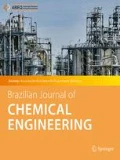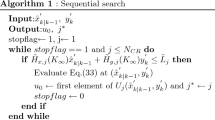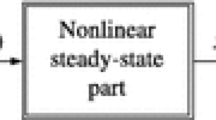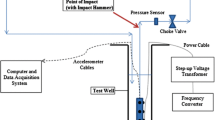Abstract
Electric submersible pumps (ESPs) are one of the most widespread oil artificial lifting technologies. In the operation of an ESP there are a large number of parameters that must be monitored and held within operational constraints in order to guarantee stable and optimal operation. Manual control is subject to sub-optimal production and constant violation of operational limits, that can cause either a reduction in ESP lifetime or premature failure. Therefore, a proper automation strategy must be applied to support operators in order to ensure the best production rate with less energy cost. Previous literature has proposed the use of linear MPC based on system identification, however all relevant system variable measurements were considered available. In this paper, the problem of losing measurements of the state variables due to the aggressive subsea environment is addressed. We show that a non-adaptive single linear model strategy lacks in quality for state estimation and, therefore, a robust MPC is not possible under this configuration. In this work, an adaptive constrained MPC coupled with a model scheduling Kalman filter (MSKF) is proposed. Two model scheduling strategies based on linear interpolation of a pre-set number of local models are proposed and compared to successive linearization at every sampling time, based on Taylor series expansion of the nonlinear model. All strategies guarantee model accuracy and model stability over the whole operational range. The proposed scheduling strategies presented similar performance compared to the successive linearization strategy, avoiding the need of obtaining a local linear model at each sampling time.






















Similar content being viewed by others
Change history
04 March 2021
A Correction to this paper has been published: https://doi.org/10.1007/s43153-021-00091-9
Abbreviations
- \(A_{1}\) :
-
Cross-section area of pipe below ESP
- \(A_{2}\) :
-
Cross-section area of pipe above ESP
- \(C_{c}\) :
-
Choke valve constant
- \(D_{1}\) :
-
Pipe diameter below ESP
- \(D_{2}\) :
-
Pipe diameter above ESP
- \(f\) :
-
ESP frequency
- \(f_{0}\) :
-
ESP characteristics ref. freq.
- \(F_{1}\) :
-
Frictional pressure drop below ESP
- \(F_{2}\) :
-
Frictional pressure drop above ESP
- \(g\) :
-
Gravity constant
- \(h_{1}\) :
-
Height from reservoir to ESP
- \(h_{w}\) :
-
Total vertical distance in well
- \(H\) :
-
Head developed by ESP
- \(I\) :
-
Electric current in ESP motor
- \(I_{np}\) :
-
ESP motor nominal current
- \({\varvec{K}}\) :
-
Kalman Filter gain matrix
- \(L_{1}\) :
-
Length from reservoir to ESP
- \(L_{2}\) :
-
Length from ESP to choke
- \(m\) :
-
MPC control horizon
- \(M\) :
-
Fluid inertia parameter
- \({\varvec{M}}_{k}\) :
-
The number of points in the grid for input \(k\)
- \(n_{u}\) :
-
Number of input variables
- \(n_{x}\) :
-
Number of state variables
- \(n_{y}\) :
-
Number of controlled variables
- \(n_{\varphi }\) :
-
Number of nodes in \(f\) in the grid of linear models
- \(n_{\zeta }\) :
-
Number of nodes in \(z\) in the grid of linear models
- \(p\) :
-
MPC predictive horizon
- \(p_{bh}\) :
-
Bottom hole pressure in well
- \(p_{m}\) :
-
Manifold pressure
- \(p_{p,in}\) :
-
ESP inlet pressure
- \(p_{p,out}\) :
-
ESP outlet pressure
- \(p_{r}\) :
-
Reservoir pressure
- \(p_{wh}\) :
-
Wellhead pressure
- \(\Delta p_{f}\) :
-
Frictional pressure drop in the well
- \(\Delta p_{p}\) :
-
Pressure difference across ESP
- \(P\) :
-
ESP brake horsepower (BHP)
- \({\varvec{P}}_{k}\) :
-
Covariance matrix of the estimation error at instant \(k\)
- \(P_{np}\) :
-
ESP motor nominal power
- \(PI\) :
-
Well productivity index
- \(q\) :
-
Average flow rate in well
- \(q_{c}\) :
-
Flow rate through production choke
- \(q_{r}\) :
-
Inflow from reservoir into well
- \({\varvec{Q}}\) :
-
Covariance matrix with respect to model state variables
- \({\varvec{R}}\) :
-
Covariance matrix with respect to output measurements
- \({\varvec{s}}\) :
-
Representation of the interpolated linear model with the Homotopic Interpolation
- \(\hat{\user2{s}}\) :
-
Representation of the interpolated linear model with the Multivariable Linear Interpolation
- \({\varvec{s}}_{i,j}\) :
-
Representation of the linear model with respect to \(\left( {\phi_{i} ,\zeta_{j} } \right)\) in the grid of models
- \({\varvec{s}}_{i}\) :
-
Representation of the interpolated linear model in the direction of \(z\) with the Homotopic Interpolation
- \({\varvec{u}}\) :
-
Vector of input variables
- \({{\varvec{\Delta}}}{\varvec{u}}_{k}\) :
-
Vector of variation of input variables: \({{\varvec{\Delta}}}{\varvec{u}}_{k} = {\varvec{u}}_{k} - {\varvec{u}}_{k - 1}\)
- \({\varvec{v}}\) :
-
Vector of the points of the grid of models in the Multivariable Linear Interpolation
- \(V_{1}\) :
-
Pipe volume below ESP
- \(V_{2}\) :
-
Pipe volume above ESP
- \({\varvec{W}}_{{\varvec{u}}}\) :
-
MPC weight matrix of input variables
- \({\varvec{W}}_{{\varvec{y}}}\) :
-
MPC weight matrix of output variables
- \({\varvec{W}}_{{{{\varvec{\Delta}}}{\varvec{u}}}}\) :
-
MPC weight matrix of the variation in the input variables
- \({\varvec{x}}\) :
-
Vector of the state variables
- \(\hat{\user2{x}}\) :
-
Vector of the predicted state variables
- \({\varvec{y}}\) :
-
Vector of the output variables
- \(z\) :
-
Production choke valve opening
- \(\beta_{1}\) :
-
Bulk modulus below ESP
- \(\beta_{2}\) :
-
Bulk modulus above ESP
- \({\varvec{\zeta}}\) :
-
Vector of the nodes in \(z\) in the grid of models
- \({\varvec{\lambda}}\) :
-
Vector of parameters with respect to \(f\) in the Homotopic Interpolation
- \({\varvec{\eta}}\) :
-
Vector of parameters with respect to \(z\) in the Homotopic Interpolation
- \(\mu\) :
-
Viscosity of produced fluid
- \(\rho\) :
-
Density of produced fluid
- \({\varphi }\) :
-
Vector of the nodes in \(f\) in the grid of models
- \({{\varvec{\Phi}}}\) :
-
Vector of weights of the Multivariable Linear Interpolation
- \(NL\) :
-
Non linear
- \(L\) :
-
Linear
- \(rt\) :
-
Reference trajectory
- \({*}\) :
-
Stationary state
- \(T\) :
-
Transpose
- \(lb\) :
-
Lower bound
- \(ub\) :
-
Upper bound
References
Bellman R (1957) Dynamic programming. Princeton, New Jersey
Binder BJ, Kufoalor DK, Pavlov A, et al (2014) Embedded model predictive control for an electric submersible pump on a programmable logic controller. In: 2014 IEEE Conference on Control Applications, CCA 2014, , n. 2, pp 579–585.
Binder BJ, Pavlov A, Johansen TA (2015) Estimation of flow rate and viscosity in a well with an electric submersible pump using moving horizon estimation. IFAC-PapersOnLine 28(6):140–146
Bruhn CH, Gomes JAT, Del Lucchese C, et al (2003) Campos basin: reservoir characterization and management-historical overview and future challenges. In: 15220 O (ed) 2003 Offshore Technology Conference, Houston, USA
Delou PA, Azevedo J, Krishnamoorthy D, de Souza Jr.Secchi MBAR (2019) Model predictive control with adaptive strategy applied to an electric submersible pump in a subsea environment. IFAC-PapersOnLine 52:784–789
Fanailoo P, Andreassen G (2008) Improving reliability and reducing intervention costs of ultra-deep subsea technology at the design stage. In: Offshore Technology Conference, pp 1–9
Furlan FF, De Andrade Lino AR, Matugi K et al (2016) A simple approach to improve the robustness of equation-oriented simulators: multilinear look-up table interpolators. Comput Chem Eng 86:1–4
Harris G, Vergara L, Souza CRN, et al (2012) ESP systems enhance reliability in challenging environments. In: Drilling & Completion, pp 2–5
Krishnamoorthy D, Bergheim EM, Pavlov A et al (2016) Modelling and robustness analysis of model predictive control for electrical submersible pump lifted heavy oil wells. IFAC-PapersOnLine 49(7):544–549
Mendonça JE, Mattos CH, Rittershaussen JH (2008) The first deepwater installation of a subsea ESP: RJS-477A, Campos Basin, Brazil. In: 10969 O (ed) 1999 Offshore Technology Conference, pp 1–9, Houston.
Pavlov A, Krishnamoorthy D, Fjalestad K, et al (2014) Modelling and model predictive control of oil wells with electric submersible pumps. In: 2014 IEEE Conference on control applications, CCA 2014, n. 3905, pp 586–592
Pinto A, Branco C, De Matos J, et al (2003) offshore heavy oil in Campos basin: the Petrobras experience. In: 15283 O (ed), 2003 Offshore Technology Conference, Houston, USA
Salau NPG, Secchi AR, Trierwieler JO (2007) Five formulations of Extended Kalman Filter: which is the best for D-RTO? In: 17th European Symposium on computer aided process engineering–ESCAPE17. January 2007.
Simon D (2006) Optimal state estimation: Kalman, h-infinity, and nonlinear approaches. Wiley, New Jersey
Takacs G (2009) Electrical submersible pumps manual: design, operations, and maintenance. Gulf equipment guides, 1st edn. Gulf Professional Publishing, Oxford
Thomas JE (2001) Fundamentos de Engenharia de Petróleo (“In Portuguese”). Interciência, Rio de Janeiro
Varón MP, Bannwart AC, Biazussi JL, et al (2013) Study of an electrical submersible pump (ESP) as flow meter. In: SPE Artificial Lift Conference-Americas. February 2016.
Wächter A, Biegler LT (2006) On the implementation of an interior point filter line-search algorithm for large-scale nonlinear programming. Math Program 106(1):25–57
Wang L (2009) Model Predictive Control System Design and Implementation Using MATLAB. N., 1st edn. Springer-Verlag London Limited, London
Author information
Authors and Affiliations
Corresponding author
Additional information
Publisher's Note
Springer Nature remains neutral with regard to jurisdictional claims in published maps and institutional affiliations.
Appendices
Appendix A. ESP process model
The ESP process model considered in the present work was proposed by Pavlov et al. (2014) and adapted by Binder et al. (2015) in order to improve its fidelity to a real well. The model is a third-order nonlinear differential–algebraic system of equations. The set of differential equation is derived by considering the system of a hydraulic transmission line with pressure loss due to friction along pipes and pressure boost due to the ESP:
The well productivity index is considered constant on the operation time scale, so the reservoir inflow rate is:
It is considered that there is always a pressure loss across the choke valve, so no backflow is allowed and the flow rate can be calculated by:
The pressure drop in each pipe section comes from Darcy–Weisbach considering the Fanning friction factor for smooth pipe and turbulent flow:
So the pressure drop in the well is the sum of both friction factors, \(\Delta {p}_{f}={F}_{1}+{F}_{2}\). It is assumed that the fluid proprieties (i.e., density and viscosity) are constant across the ESP, so the multi-stage pump can be modeled as a number of single-stages. Moreover, the fluid is considered incompressible; therefore, the affinity laws presented by Takacs (2009) are valid and the pump equations are:
The model parameter values considered in the present study are shown in Table 9.
\({H}_{o}\) and \({P}_{0}\) in Eqs. (22) and (23), respectively, are head and power characteristic curves of the pump at a reference frequency \({f}_{0}\) and for water as a fluid (\(\mu =1 cP\)). \({C}_{q}\), \({C}_{H}\) and \({C}_{P}\) in Eqs. (21), (22) and (23) are viscosity correction factors for flow, head and power. The characteristic curves and the viscosity correction factors are polynomial functions (Binder et al. 2015):
where \(x\) denotes \({q}_{0}\) for the characteristic curves and \(\mu\) the viscosity correction factor.
Appendix B. System linearization strategy
The linearization strategy followed the Taylor series expansion truncated in the first order element, resulting in the following linear system written in the matrix form:
in which \({\varvec{x}}\), \({\varvec{u}}\) and \({\varvec{y}}\) are respectively state, input and output variables in a reference state deviation notation.
Let \(d{\varvec{x}}\left(t\right)/dt\) be represented by a function of \({\varvec{x}}\) and \({\varvec{u}}\), such as:
The elements of matrices \({\varvec{A}}\), \({\varvec{B}}\), \({\varvec{C}}\) and \({\varvec{D}}\) can be calculated by the analytical derivatives of \(\mathcal{F}\) and \({\varvec{y}}\) over \({\varvec{x}}\) and \({\varvec{u}}\):
The elements of the Jacobian matrix, \({\varvec{A}}\), are:
The elements of matrix \({\varvec{B}}\) are:
The elements of matrix \({\varvec{C}}\) are:
Finally, the elements of matrix \({\varvec{D}}\) are:
In which,
It is noteworthy that a relative deviation approach enhances the controllability of the system. This is a normalization strategy to deal with the different order of magnitude of the variables. The system notation adopting the relative deviation is:
in which \({\varvec{z}}\), \({\varvec{\mu}}\) and \({\varvec{w}}\) are, respectively, state, input and output variables in a reference state relative deviation notation.
Taking the system in a reference deviation notation, it is possible to find the equivalent matrices in the fractional reference deviation by applying the following transformations:
in which \({\widehat{a}}_{i,j}\), \({\widehat{b}}_{i,j}\), \({\widehat{c}}_{i,j}\) and \({\widehat{d}}_{i,j}\) are the elements of matrices \(\widehat{{\varvec{A}}}\), \(\widehat{{\varvec{B}}}\), \(\widehat{{\varvec{C}}}\) and \(\widehat{{\varvec{D}}}\), respectively.
Rights and permissions
About this article
Cite this article
Delou, P.A., de Souza, M.B. & Secchi, A.R. Addressing the lack of measurements in the subsea environment by using a model scheduling Kalman filter coupled with a robust adaptive MPC. Braz. J. Chem. Eng. 38, 683–703 (2021). https://doi.org/10.1007/s43153-020-00079-x
Received:
Revised:
Accepted:
Published:
Issue Date:
DOI: https://doi.org/10.1007/s43153-020-00079-x




